Common Bridge Types
From DT Online

Description
There are only a few types of bridge which are really different to each other:
- Beam Bridges are simply like a log or a plank lying across the gap or stream (Beam is an old word for tree - such as found in Hornbeam or Whitebeam for example).
- Many old Arch Bridges can be found made of stone and there is also one made of Cast Iron at Coalbrookdale.
- Some bridges look as though they are hanging from long wires and these are called Suspension Bridges.
- Bridges like the famous Forth Railway Bridge are known as Cantilever Bridges - these are a little like two diving boards sticking out towards each other and holding up a joining piece in the middle.
There are also some very modern bridges which look similar to Suspension Bridges but all the wires go straight back to their supporting towers instead of a suspension cable strung between them - these are called Cable Stayed Bridges.
Some bridges have decks or whole structures which can move out of the way to let traffic pass under and these are called Moveable Bridges which have sections that hinge, swing, lift or move in some way to allow the passage of tall boats for example - see Visual index of moving bridges.
Beam Bridges
| Beam Bridges are the oldest and simplest bridge design consisting of vertical piers and horizontal beams - (e.g. just a simple plank or stone slab). They are suitable only for short spans but can used for larger crossings by adding additional piers. | 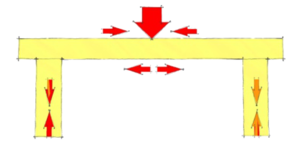 | |
| Forces: | As the bridge is loaded, by traffic for example, the beam bends which causes the top surface to be compressed and the bottom surface to be stretched or put in tension. | |
| Advantages: | They are easy to build and inexpensive relative to other bridge types so are very common. | |
| Disadvantages: | They have a limited span so may need additional piers and may not allow large boats or vehicles to pass underneath unless positioned on high embankments. | |
Truss Bridges
| Truss Bridges are structures built up by jointing together lengths of material to form an open framework - based mainly on triangles because of their rigidity. They are very strong yet relatively light in weight and can support heavy loads. | 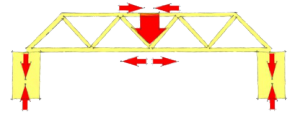 | |
| Forces: | As with a Beam Bridge the top of a loaded truss is placed in compression and bottom in tension. These forces are shared among the angled members. | |
| Advantages: | They are light and strong, making efficient use of materials. | |
| Disadvantages: | They are more complex to construct than plain Beam Bridges and need a higher level of maintenance. | |
Arch Bridges
| Arch Bridges were known in Ancient Greece and by the Romans and have been in use ever since. They are often chosen for their strength and appearance. | 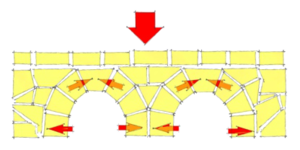 | |
| Forces: | The compressive forces created by the load are transferred down through the arch and resisted by the supports, or abutments, at its base. Abutment support prevents the arch spreading under load. | |
| Advantages: | They are very durable, strong, and can easily be built over timber Falsework from a wide variety of materials including locally found masonry. | |
| Disadvantages: | Limited spans unless multiple arches (or Viaducts) are used - in which case all arches have to be raised together to balance sideways thrusts. They are labour intensive, require heavy foundations, and are generally uneconomic in their use of materials. | |
Suspension Bridges
| Suspension Bridge main elements are a pair of main suspension cables stretching over two towers and attached at each end to an anchor buried deep in the ground. Smaller vertical suspender cables are attached to the main cables to support the deck below. | 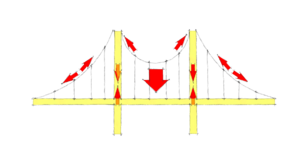 | |
| Forces: | Any load applied to the bridge is transformed into a tension in the main cables which have to be firmly anchored to resist it. | |
| Advantages: | Lightweight, strong and can span long distances such as across rivers | |
| Disadvantages: | Expensive, complex to build and prone to movement in high winds so not suitable for railway crossings. | |
Cantilever Bridges
| Cantilever Bridges are based on structures that project horizontally into space, supported at only one end - like a spring board. | 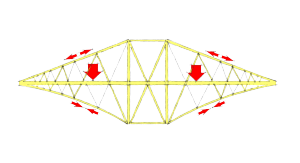 | |
| Forces: | If two cantilevers project out from a central pier the forces are balanced. | |
| Advantages: | More easily constructed at difficult crossings by virtue of using little or no Falsework. | |
| Disadvantages: | Complex structures and can be difficult to maintain | |
Cable-stayed Bridges
| Cable Stayed Bridges may appear to be similar to Suspension Bridges, but in fact they are quite different in principle and in their construction. There are two major classes of cable-stayed bridges: Fan type, which are the most efficient, and Harp or parallel type, which allow more space for the fixings. | 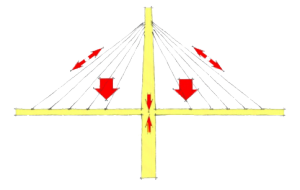 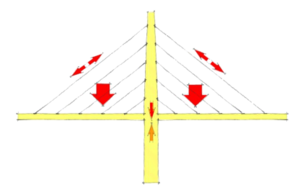 | |
| Forces: | As traffic pushes down on the roadway, the cables, to which the roadway is attached, transfer the load to the towers, putting them in compression. Tension is constantly acting on the cables, which are stretched because they are attached to the roadway. | |
| Advantages: | Good for medium spans, greater stiffness than the suspension bridge, can be constructed by cantilevering out from the tower, horizontal forces balance so large ground anchorages are not required. | |
| Disadvantages: | Typically more expensive than other types of bridge, except suspension bridges. | |

Activity: A good way of understanding how these various bridge designs work, their advantages and disadvantages, is to make models and test them.
Choose a 'standard' gap to span, build models to cross it, weigh each model (and also note the time and trouble taken to make it) then test each model by loading it until it fails. Divide maximum load by self-weight to get a measure of its efficiency - good models will produce results between 1000 and 2000 on this test!
- Structures and Frames can also be modelled using the Construction Kits listed in the Truss Bridges and Looking at Bridges articles.
Safety Point! Take great care with hot glue guns and all hot-melt glues. The melted glue can stick to the skin and cause severe burns.
 |
 |
 |
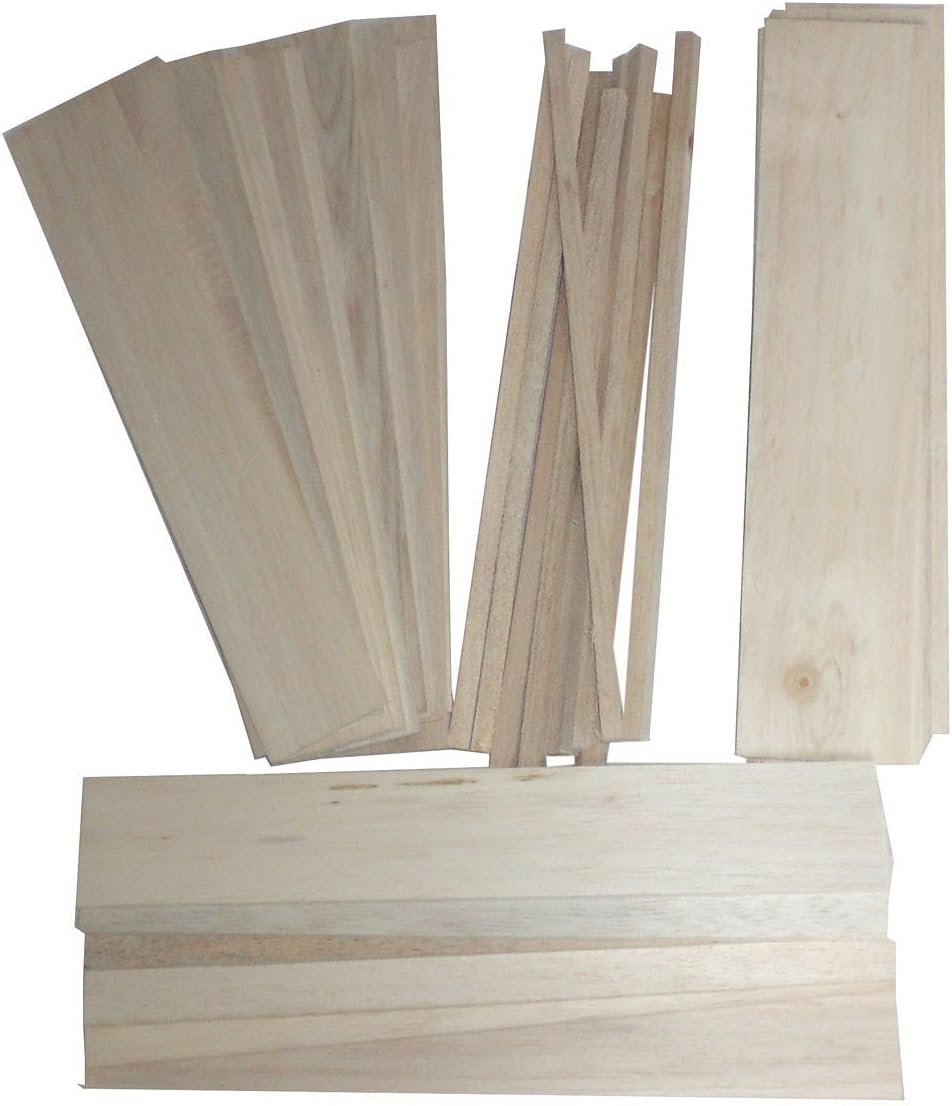 |
 |
 |
 |
 |
 |
 |
 |
| Junior Hacksaw |
Clamp-on Hobby Vice |
Stripwood |
Balsa Wood |
Medium card coloured |
Thick card coloured |
Cutting Mat |
10mm Squared Paper |
PVA glue |
Glue Gun |
Bamboo Flower Sticks |
Notes:
- Choose metal cutting hacksaw blades - the teeth are small which suits this scale of work and they are safer for young children
- School PVA glue is best for young children because it is non-toxic and washes off : PVA Wood Glue is strongest but must be used with care.
- Try to get natural Flower Sticks or wear gloves because the green stain comes off on hands!